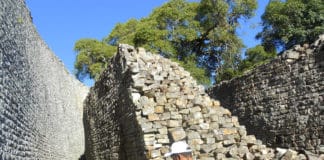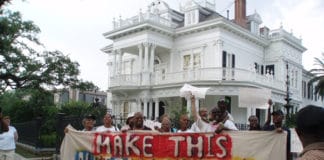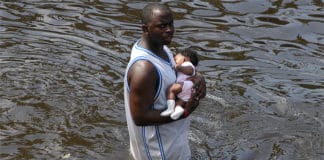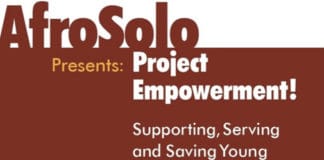Tags Schools
Tag: schools
On the unspeakable history of animal cruelty at the Hunters Point...
In the protracted work of Dr. Ahimsa Sumchai to research, educate and eradicate the harms of the deadly dumping of killer contaminants at Hunters Point Naval Shipyard, Sumchai exposes the additional history of animal radiation experiments compounding the suffering.
Prison strike organizers to protest food giant Aramark
The people who organized the country’s biggest prison strike against what they call modern-day slavery have planned their next target: corporate food service giant Aramark. The $8.65 billion company is one of the country’s largest employers and serves food to more than 100 million people a year. It also provides meals for more than 500 correctional facilities across the country and has been the subject of complaints about maggots and rocks, sexual harassment, drug trafficking and other employee misconduct.
Bay Area Black doctor plans to repatriate to South Africa
I talked to a future repatriate, my comrade Dr. Chris Zamani, about his recent trip to South Africa in search of a homeland and a place for him to stick his flag. I talked to him about some of the factors that he has to consider in order to prepare to make that move. He has a very interesting outlook on history and life that is driving his decision to want to leave the U.S., and I wanted to share this ongoing conversation that we have been having with each other for the last few years. Check out Dr. Zamani in his own words ...
New Orleans land grab: Addressing the ‘elephant’ in the city 10...
As we approach the 10th anniversary of Hurricane Katrina, let’s not ignore the “elephant” in New Orleans, notwithstanding the pressure to do just that. The elephant in our city is the rampant land grab displacing predominantly African American residents to the outskirts of the city, where public safety, reliable transit, nearby schools, accessible job opportunities and neighborhood amenities are lacking.
‘Katrina: After the Flood’
The New York Times sent Gary Rivlin to Baton Rouge and New Orleans, days after the storm, to cover Katrina as an outsider. Rivlin’s instincts had him looking forward “to the mess ahead. Eventually the flood waters would recede. How would New Orleans go about the complicated task of rebuilding?” This carefully researched, beautifully written book describes that process from then until now.
Dear Black men: Help us save the lives of young Black...
Inspired by President Barack Obama’s “My Brothers Keeper” initiative, AfroSolo will launch Project Empowerment: The Audacity to Succeed II. An anthology entitled “Lighting up the Future: Letters From Black Men to Young Black Men and Boys,” will be a collection of letters from Black men designed to celebrate, uplift and motivate young Black men and boys to successfully transcend youth to adulthood. We cordially invite your participation.
The Census form: Send it back!
It’s time to be counted. Every day, the average American gets 1.7 pieces of direct mail; in March they will get another in the form of the 2010 Census. The 2010 Census is being mailed to more than 130 million households, including America’s 8.5 million Black family households. Fully a third of these households aren’t expected to send their forms back.
Earthquake in Haiti: Under Aristide, Haitians were prepared for disaster
There was an emergency service system established in Haiti under the government of President Aristide. We had trained people, trained volunteers everywhere in Haiti. There were buildings with materials and goods stocked there, so in case of an emergency, people would have the means to survive.
An open letter to Speaker Pelosi: Make good on your promise...
On Aug. 29, 2005, Hurricane Katrina took the lives of more than 1,836 people, displaced more than 1 million residents, and damaged more than 200,000 Gulf Coast homes in a 90,000 square mile area. The damage caused by the flooding, storm surge and high winds destroyed schools, hospitals, roads, community centers, bridges, parks and forestlands. In the end, the Gulf Coast suffered more than $100 billion in damage, making Katrina the costliest and most deadly hurricane in the history of the United States.










